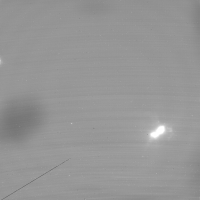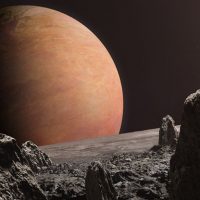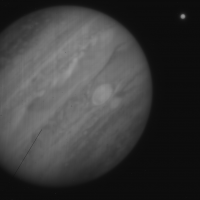One of the questions that comes up often enough is what do the pictures look like? And that question is followed by… Where can I see them.
The problem… Science data is usually pretty ugly.
Keep in mind that the astronomers are often pushing the telescopes and instruments right to the limit. This means that the data is barely there, a trickle of photons that have come from unimaginably distant sources.
I have been in the observing room as the data comes in. I have watched over the telescope operator’s shoulder. It is strange to see folks so excited over a smudge.
See it? There is it!!
Yes I do see it… It is a smudge. A smear of grainy pixels in the image, or a barely perceptible line in a spectrum. That smudge might represent a few photons that left a galaxy ten billion years ago, the astronomers are thrilled… It is still a smudge.
Above I posted an image of Jupiter taken with the NIRC2 camera and the Keck 2 AO system. Planetary images like this are one of the exceptions to the rule, even the raw frame looking reasonably decent, better than the usual smudge.

The usual image is more like this one…
Actually they get worse, this is at least slightly recognizable as a galaxy. Most of the images are completely unrecognizable when first viewed.
A raw image will show a multitude of artifacts from the camera detector, odd lines, detector defects, cosmic ray artifacts, and more. Much of these issues can be corrected using proper calibration of the image, leaving a slightly less ugly image which is still pretty ugly.
All but a mere few science images will ever be seen beyond the astronomers who first took the image. Most will never be processed into a decent looking image, at best basic calibrations will be done to allow the needed data to be extracted.
Can I see them? Sure. The entire Keck Observatory archive is online where anyone can search and download images. Most large observatories place their data into public access archives. The data is available exclusively to the astronomer who took the data for a short time, usually a year or 18 months, after which it becomes public. The raw images you see here were downloaded from the Keck archive.
The only real issue is that the images are in FITS format. FITS is just another image format like JPG or GIF. Developed for astronomy it also allows the image to be properly calibrated and important information like instrument configuration, dates, and target coordinates stored in the file alongside the data.
You can download a free program like Irfan View that can view FITS, with the right plugin. There is also FITS Liberator published by ESO that runs on Windows or MacOS.
It is an odd paradox in astronomy, most of the impressive photographs of our universe come from amateur astronomers using comparatively tiny telescopes. And while those small telescopes might cost tens of thousands of dollars, this is vastly less expensive than the hundreds of millions it takes to build the largest research telescopes.

To visualize many of the discoveries made by the largest telescopes the images we see are and artist’s reconstruction of the object. These may be images based on real data, but they are still just that, real data interpreted by a skilled artist into what the object might look like.
The result of this can often confuse the general public. Why no real images of this latest discovery? Where are the real photos? Why is the newspaper publishing an artist’s rendition?
The answer is simple… Most science images are ugly.


